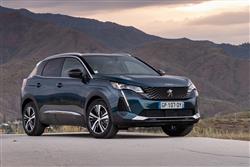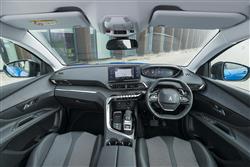Peugeot 3008 - ABC Leasing
How will you view?
This is a sample, showing 30 seconds of each section.
CROSS THE TRACKS(some text hidden)
By Jonathan Crouch
Ten Second Review word count: 119
In you're shopping amongst volume brand models at the upper end of the mid-sized SUV segment, Peugeot's 3008 SUV is one of the cars you'll need to seriously consider. The second generation version we first saw in 2017 has been lightly updated in recent times, most notably with 48V mild hybrid engine tech for the base petrol variant most customers choose. As before, smart looks clothe familiar attributes like a large, versatile boot and a quality cabin. You have to really want a car of this kind to really appreciate it but if you do, then you'll probably like this one a lot. There's near-premium pricing though, particularly for the clever Hybrid PHEV Plug-in models that top the range.
Background word count: 156
Any car maker wanting to develop, build and sell a Crossover SUV in today's crowded market knows that the product concerned is really going to have to stand out. There are, after all, so many brands jostling for space in this segment. Has this improved version of Peugeot's second generation 3008 model got what it takes? This 3008 sits in the middle of Peugeot's SUV line-up, just above the supermini-based 2008 and just below the larger and more luxurious seven-seat 5008. Whereas the first generation 3008 competed directly against the most affordable Nissan Qashqai and SEAT Ateca-shaped mid-sized SUVs, this MK2 model, first launched in 2017, was moved a little more up-market to compete with slightly larger and more sophisticated mid-sized models like Volkswagen's Tiguan, Ford's Kuga and the Mazda CX-5. It shares its EMP2 chassis and engineering with the Stellantis Group's other mid-sized SUVs, the Citroen C5 Aircross, the Vauxhall Grandland and the DS 7.
Driving Experience word count: 442
Come to this car without previously knowing much about it and to begin with when first you set off, there's a nagging sensation in your head that something is different. By the time you put your finger on what that is, you might have already decided you rather like it, the change in question being the size and positioning of this tiny steering wheel with its curious flattened top and bottom sections. It comes as part of an 'i-Cockpit' design used not only on this 3008 but on all of Peugeot's smaller models, the concept based around viewing the instrument binnacle above the wheel rather than conventionally through it. That means the wheel can be smaller and positioned closer to the driver, giving a more connected feel that encourages wrist-flick direction changes. And it's still one of the best-riding Crossovers of its kind. Under the skin, most of the mechanicals are shared with the French maker's 308 family hatch, including the sophisticated EMP2 platform, which means that, as ever, the 3008 is primarily built around a front wheel drive platform. The engine line-up is carried over from other models in the brand's range and all units are mated to EAT8 8-speed auto transmission. There are two straightforward units - the familiar 130hp 1.2-litre PureTech petrol and the 1.5-litre BlueHDi 130hp diesel. But Peugeot would rather you considered its latest Hybrid 136 e-DSC6 powertrain, which mates a 48V mild hybrid electrification with the 1.2-litre petrol unit we mentioned earlier. At the top of the range remain two 1.6-litre Plug-in Hybrid engines, respectively developing either 225hp or 300hp. With these PHEVs, the electrified driving range varies between 34-36 miles. Of all the engines just mentioned, Peugeot thinks that going forward, the mid-level e-DSC6 self-charging 1.2-litre Hybrid unit should prove particularly popular. With this, the familiar PureTech unit puts out 136hp and is paired with a 28hp electric motor, working via a six-speed dual-clutch auto gearbox - and a 48v battery that charges while driving. With this set-up, when the car is decelerating, the petrol motor shuts off completely, allowing the electric motor to generate energy to recharge the battery. At higher speeds, the combustion engine stops when the driver releases the accelerator pedal at a steady speed and when slowing down. When the engine is under high load, such as during overtaking, the electric motor provides additional torque with a one-off boost that compensates for the turbo's response time. This is intended to avoid the need for downshifts and, Peugeot hopes, should provide more driving comfort and dynamism. When the driver presses the accelerator fully, the electric motor provides an additional 12hp of power.
Pictures (High res disabled)

.jpg)
.jpg)
.jpg)
.jpg)
.jpg)
.jpg)
.jpg)
.jpg)

Scoring
Category: Compact Car
| Performance | |
| Handling | |
| Comfort | |
| Space | |
| Styling | |
| Build | |
| Value | |
| Equipment | |
| Economy | 70% |
| Depreciation | 70% |
| Insurance | 70% |
| Total | 75% |